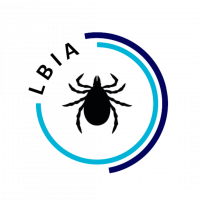RESEARCH LINE
Ticks are ectoparasites that feed on the blood of vertebrate animals (hosts), being versatile vectors of a wide diversity of pathogens. Among the pathogens transmitted to humans by ticks, Rickettsia rickettsii, the etiological agent of Brazilian spotted fever (BSF – for more information about the disease, access the link), is one of the most lethal.
R. rickettsii can be perpetuated for subsequent generations in tick populations of BSF endemic areas, as it presents transovarial transmission (transmission from the mother to the progeny), besides transstadial transmission (from one stage of the tick life cycle to another). Then, in addition to being vectors, ticks are reservoirs of the bacteria in nature.
In Brazil, R. rickettsii is transmitted to humans by the bite of the ticks Amblyomma sculptum and Amblyomma aureolatum. These two tick species exhibit remarkable differences in terms of susceptibility to infection by R. rickettsii (A. sculptum is much less susceptible than A. aureolatum). Our research group previously reported that A. sculptum genes modulated by R. rickettsii infection are mostly upregulated in the tick gut, including components of the immune system, whereas in A. aureolatum most genes are downregulated. We also showed that the gut of A. aureolatum has a prominent microbiota, while the gut of A. sculptum is practically sterile. Taken together, these data suggest that the microbiota, instead of activating, desensitizes the immune system in the A. aureolatum gut, creating a favorable environment for the establishment of R. rickettsii. We have also demonstrated that microplusin, an antimicrobial peptide, is one of the immune factors involved in the control of R. rickettii infection in the gut of A. aureolatum. Apoptosis also acts in the defense against pathogens, since programmed death of the infected cell prevents the spread of infection to adjacent cells. Interestingly, we showed that R. rickettsii has the property of inhibiting the apoptosis of tick cells, favoring their growth.
The transmission of R. rickettsii to the vertebrate host occurs via tick saliva. Preliminary immunological assays showed that some proteins from the saliva of A. sculptum have the ability to stimulate both cellular and humoral immunity in the murine model, being potential targets for blocking the bacterial transmission.
The current studies aim to characterize the molecular and cellular factors involved in the interactions among R. rickettsii, tick vectors, the microbiota and the vertebrate host, in order to identify targets for the development of strategies to control BSF. For this, we use different techniques, such as RNA interference (RNAi), quantitative PCR (qPCR), metagenomics analysis and flow cytometry. For the development of the projects, we rely on the infrastructure of the LBIA, the laboratories of our collaborators, and the biosafety laboratory 3 (BSL-3) of the Department of Parasitology of ICB-USP, designed and implemented by the professors Andrea Fogaça and Carsten Wrenger.
